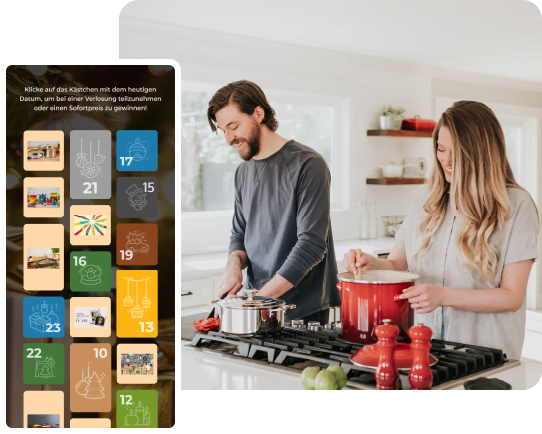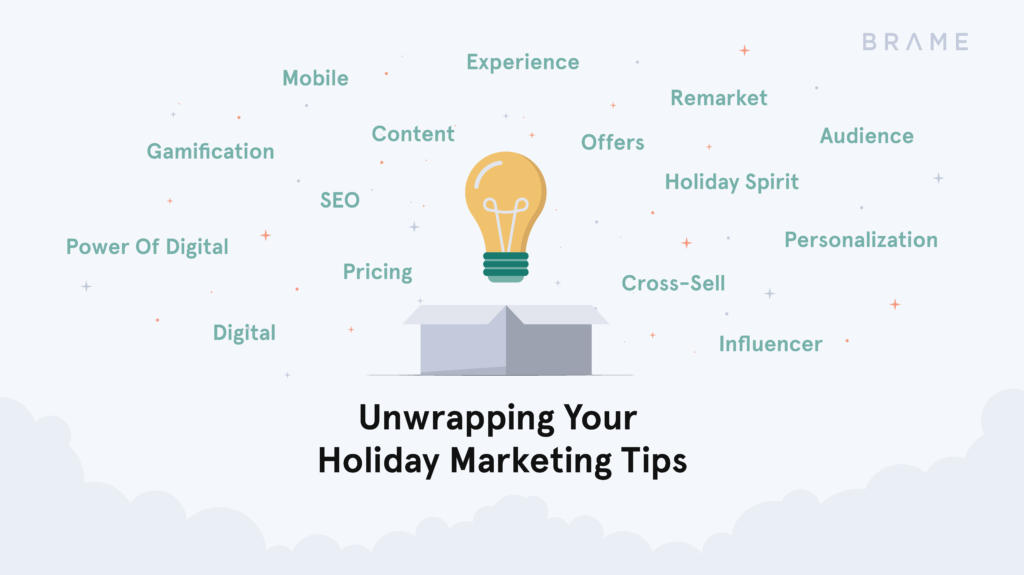The holiday season, heralded by events like Black Friday, is more than just a festive period of gift-giving and merry-making.
It is also a pivotal time for marketers worldwide because it is teeming with golden opportunities for unprecedented sales and customer engagement.
With consumers ready to spend their money on gifts for their loved ones and themselves, businesses can tap into the festive spirit to increase sales and build trust.
In this post, we discuss:
- Why holiday marketing makes business sense
- Holiday marketing examples from other brands
- Tips for you to prepare your business for the holidays
- 15 Marketing tips to boost holiday sales
We will also provide a handy holiday calendar to help you plan for the important holidays over the winter festive season.
Why Holidays Matter To Marketers
Holiday sales are a lucrative event for any business. Data consistently shows an upward trend in holiday spending, making it a period of increased revenue and customer engagement.
Whether it is Halloween, Black Friday, or the start of Advent, each holiday is an opportunity to reach new target audiences, stimulate sales, and foster long-term customer loyalty.
Businesses that can create unique, branded holiday marketing campaigns targeted to their audience’s needs stand to carve out a significant competitive advantage.
Holiday Marketing Calendar
- Halloween
- Black Friday
- 1 December (Start of Advent)
- St. Nicholas Day
- Holy Night (Christmas Eve)
- Christmas
- New Year’s Eve
- New Year’s Day
- Drekönigstag (Epiphany)
- Blue Monday
- January Winter Sales
During the holidays, you can connect with your customers, amplify your brand’s voice, and drive traffic to your website or boost sales.
But holiday marketing success hinges on timely preparation, understanding the cultural context of each holiday, and offering tailored experiences that resonate with your audience.
We will look at how to prepare for holiday sales later in this article.
To help you plan a year-round approach, let us examine a holiday marketing calendar showing some key dates, ideas, and start times for your festive campaigns.
October
Halloween: October 31st
- Campaign Start: Early to Mid-October
- About: A holiday celebrating the dead by dressing up in costumes, going door-to-door, sharing candies, and hosting spooky-themed events.
- Celebration: People often host and attend costume parties, trick-or-treat, and decorate their homes.
- Marketing Ideas: Showcase Halloween-themed products, run a ‘spooky’ sale, or launch a Halloween-themed contest or gamified campaign on social media.
- When To Start Preparing The Campaign: Mid-August
November
Black Friday: Fourth Friday in November
- Campaign Start: Early November
- About: The day after Thanksgiving Day typically marks the start of the Christmas shopping season with significant sales. In 2023, Black Friday falls on November 24.
- Celebration: Consumers take advantage of massive online and offline sales and promotions.
- Marketing Ideas: Consider early-bird sales, time-limited offers, and bundle deals. Utilize email and social media marketing to promote your sales.
- When To Start Preparing The Campaign: Mid-August – Early September
December
Start of Advent: December 1st
- Campaign Start: Mid-November
- About: Advent marks the start of the Christmas season and the anticipation of Christmas.
- Celebration: Many people use Advent calendars to count the days in anticipation of Christmas.
- Marketing Ideas: Create a digital advent calendar with a different deal or content revealed daily.
- When To Start Preparing The Campaign: Early-Mid September
St. Nicholas Day: December 6th
- Campaign Start: End of November
- About: Children receive gifts from Saint Nicholas.
- Celebration: Children put their boots outside their doors, hoping to find them filled with gifts in the morning.
- Marketing Ideas: Offer special Nikolaus discounts or launch a themed campaign around gift-giving.
- When To Start Preparing The Campaign: Mid-September
Holy Night (Christmas Eve): December 24th
- Campaign Start: Early December
- About: The night before Christmas is traditionally a time for family gatherings and gift exchanges.
- Celebration: Many families have a special meal, sing carols, and exchange gifts.
- Marketing Ideas: Send personalized wishes to your customers or offer special last-minute Christmas deals.
- When To Start Preparing The Campaign: Mid- to Late September
Christmas: December 25th
- Campaign Start: Early December
- About: A significant holiday celebrating the birth of Jesus Christ.
- Celebration: People celebrate with special meals, gift-giving, and religious ceremonies.
- Marketing Ideas: Share a heartfelt message with your audience, offer special Christmas deals, or give away branded Christmas-themed items.
- When To Start Preparing The Campaign: Mid- to Late September
New Year’s Eve: December 31st
- Campaign Start: Mid-December
- About: New Year’s Eve marks the final day of the Gregorian year and is often celebrated with parties and fireworks at midnight.
- Celebration: People celebrate with parties, concerts, and fireworks displays.
- Marketing Ideas: Launch end-of-the-year sales, host a special New Year’s event, or run a countdown with vouchers, discounts, or content revealed hourly.
- When To Start Preparing The Campaign: Late September to Early October
January
New Year’s Day: January 1st
- Campaign Start: End of December
- About: The first day of the new year is often seen as a time for fresh starts and new beginnings.
- Celebration: People celebrate with fireworks, parties, and New Year’s resolutions.
- Marketing Ideas: Launch a campaign around New Year’s resolutions, or offer discounts to those who share their resolutions.
- When To Start Preparing The Campaign: Late September to Early October
Blue Monday: January 15th
- Campaign Start: Early January
- About: Supposedly the most depressing day of the year due to a combination of post-Christmas blues, cold and dark nights, and unpaid credit card bills.
- Celebration: Many people use it as a time to focus on self-care and positive changes.
- Marketing Ideas: Offer uplifting deals, promote products that encourage self-care, or run a positivity-themed social media campaign.
- When To Start Preparing The Campaign: Mid-October
January Winter Sales
- Campaign Start: Start of January
- About: A time when retailers often offer sales to clear their remaining winter stock.
- Celebration: Smart consumers often save up money to spend at the end of the season on winter sale items. As children and students prepare to go back to school, these sales often promote essential items such as clothing, stationery, and food.
- Marketing Ideas: Promote your sales across all marketing channels and offer additional incentives for bulk purchases or referrals.
- When To Start Preparing The Campaign: Mid- to Late October
Remember that it is vital to encourage consistent engagement throughout the year. Seasonal campaigns can boost sales, but continuous interaction with your target customers is the real key to a successful holiday marketing strategy.
But with that said, there are a few ways to prepare for holiday sales campaigns to ensure they run smoothly and produce the desired results.

How To Prepare For Holiday Sales
- Timing Is Everything
- Set Clear Goals And KPIs
- Prepare Your Content And Marketing Collaterals
- Ramp Up Your Website
- Do Not Forget Stock Management
- Gear Up Your Customer Service
- Leverage Data And Analytics
- Test, Test, Test
Successful holiday marketing requires meticulous planning and execution. It is about knowing when to start your marketing efforts, managing stock during high-demand periods, and ensuring your customer service team is ready for the holiday rush.
Remember that you need to brief your marketing, design, and sales teams and provide enough time to design and produce the materials needed to run your holiday campaigns.
1. Timing Is Everything
The proverbial early bird gets the worm, and the same often applies to holiday marketing. Brands need to commence their holiday marketing campaigns early enough to capitalize on the consumers’ anticipation of holiday deals.
Our calendar section above has provided some tried-and-tested guidelines for when to start running holiday campaigns.
For example, if you would like to run a Spin The Wheel Game for your brand’s Black Friday promotion, you would need to set the game live in the first week of November. This means you should start organizing your campaign at least 2 months ahead (or even earlier if you would need to purchase a tool and have to involve several departments into the process).
Black Friday Planning Timeline:
- Last Week Of September: Brainstorm, plan, delegate tasks, set up project task deadlines.
- First Week Of October: Create rough draft of your holiday Spin The Wheel Game and test functionality. Brief content and design teams to create marketing materials (newsletters, blog posts, social media posts, web pages with game embeds, flyers with QR codes, etc.).
- Second Week Of October: Make improvements to the game, set up and test prize management (discounts, coupons, products, etc.) and delivery. Review and refine first drafts of marketing collateral.
- Third Week Of October: Deliver and print marketing collateral (if applicable). Printed materials may take longer to refine than digital assets, so allow enough time for this. Attend to any bugs or suggestions to improve your game, and get testers to try it out.
- Last Week Of October: Final checks and scheduling posts.
- First Week Of November: Launch the campaign, share on social media and other channels, and monitor responses.
2. Set Clear Goals And KPIs
What do you want to achieve with your holiday marketing? Is it increased sales, new customers, or greater brand awareness?
Defining your objectives upfront helps guide your strategy and gives you a milestone for success.
It is also crucial to decide what metrics you will be measuring to gauge the success of your holiday campaign. Some of the most popular ones include:
- Click-through rate (CTR)
- Conversions (actual sign-ups or transactions)
- Average basket size
- Average Single Transaction Value (ATS)
- Average Order Value (AOV)
3. Prepare Your Content And Marketing Collaterals
Holiday-themed banners, landing pages, social media posts, emails, and newsletters create a festive vibe and draw customers in. As mentioned earlier, start working on these well in advance. Consistency in your visual messaging across all platforms helps drive your campaign and reinforce your brand image.
Create a holiday marketing plan outlining what content will be posted when and where. This includes all content and promotional emails. Your content should aim to engage, inform, and inspire your audience.
Offer holiday tips, gift guides, and promotional information to keep your audience hooked.
4. Ramp Up Your Website
You can expect increased traffic to your website during the holiday season, especially if you are running a seasonal marketing campaign.
Ensure your website can handle the surge without compromising speed or user experience.
Optimize your site’s load time, ensure your responsive design works as expected, and provide simple and intuitive navigation. Your product descriptions and product stock counters should be updated. And, of course, the sales prices should be accurate.
A slow or confusing website can turn away potential customers, especially during the hustle of the holiday shopping season.
5. Do Not Forget Stock Management
Inventory management is crucial during the holidays. Businesses must ensure they have enough stock to meet the increased demand and avoid disappointing customers with out-of-stock notices.
If you have past holiday campaign results, you can use this data to plan how much extra stock you should keep.
6. Gear Up Your Customer Service
Preparing your customer service team to handle increased urgent customer queries and provide exceptional service will contribute significantly to a successful holiday sales season.
Ensure your delivery and return policies are easy to find on your website and that customers know what procedure to follow to log their queries.
When a customer has a bad experience, it often comes down to communication. Your customer service team should be able to provide updated information regarding holiday shipping cutoff days and times and when in-demand products will be restocked.
To give your holiday shoppers the best experience (that will keep them coming back for deals every year), ensure your team provides a positive delivery experience, too.
7. Leverage Data And Analytics
Customer data and analytics can inform your holiday marketing strategy and reveal holiday purchase trends.
Understanding your loyal customers’ purchasing habits, preferences, and behaviors can give you a better idea of how to target your marketing for maximum impact.
You can also improve drop-off rates by sending creative cart abandonment emails, redirecting to dedicated holiday landing pages, and sending quick email reminders to keep your seasonal deals top-of-mind.
If these marketing tactics do not bring back customers to complete their purchases, you can also consider sending out a quick email survey to gather data about their shopping experiences.
8. Test, Test, Test
Finally, test everything. Test your emails, website load time, check-out process, and promotional offers.
Rigorous testing helps you catch any potential issues before they affect your customers. The more seamless your customer’s experience, the more likely they will convert and return.
Learn From Other Brands: Holiday Marketing Success Stories
The power of holiday marketing is best illustrated through success stories. Let us examine four case studies of brands that excelled in their holiday marketing efforts.
FC St. Gallen
Founded in 1879, FC St. Gallen is the oldest football club in Switzerland. The club wanted to leverage the Black Friday weekend to push online and offline fan shop sales.
FC St. Gallen created a Scratchcard Game with hidden discount coupons for fans to redeem when purchasing merchandise at their stores. They promoted the campaign across the clubs’ social media channels, website, shops, and newsletter.
This successful holiday marketing campaign saw over 3,000 games played, with one in two players redeeming their discount coupons. This led to a 50% increase in sales.
Conrad Electronics
A European retailer for electronics and technology, Conrad Electronics tapped into the power of gamification during the holidays.
They created a Spin The Wheel Game to distribute discount coupons for their Black Friday campaign.
With this Black Friday promotion, Conrad Electronics saw more than 31,000 visits to their website, and 94% of the visitors played the game to secure one of the coveted discount codes.

Kuhn Rikon
A trusted manufacturer of kitchen utensils and related goods, Kuhn Rikon sought a way to boost sales during the festive season.
The company created an Advent Calendar with special promotions hidden behind each day’s door. This gamified seasonal campaign far outreached their expectations.
Kuhn Rikon saw over 142,000 visitors and a 131% increase in page sessions compared to previous holiday campaigns.
These success stories underscore the efficacy of gamification in holiday marketing. Gamification is one of the most effective strategies businesses can adopt to drive customer engagement and boost holiday sales.

Unwrapping Your Holiday Marketing Tips
Having set the stage for our holiday marketing guide, let us dive into the 15 key tips you can employ to boost holiday sales.
- Know Your Audience Inside Out
- Personalization
- Stir Up The Holiday Spirit
- Harness The Power Of Digital
- Create Shareable Content
- Leverage Influencer Marketing
- Optimize For Mobile
- Utilize SEO Best Practices
- Level Up With Gamification
- Craft Irresistible Limited-Time Offers
- Perfect Pricing
- Upsell And Cross-Sell
- Streamline The Checkout Experience
- Encourage Customer Reviews
- Retarget And Remarket
Tip #1: Know Your Audience Inside Out
Targeted messaging is key. The more you understand your customers – their likes, dislikes, preferences, and purchasing habits – the better you can tailor your marketing messages to resonate with them.
Tip #2: Personalization
Shopping can be a profoundly personal experience, and personalization can significantly enhance the customer experience. Send personalized emails to your customers and show relevant product recommendations when they are engaged in online shopping.
Even showing their name at the top of your welcome page provides a touch of personalization that can make customers feel valued and improve conversion rates.
Tip #3: Stir Up The Holiday Spirit
The holidays have a certain emotional appeal. Beyond seasonal products, holiday decorations, and the legend of Santa Claus, holiday cheer brings people together to celebrate a culture and history they value.
You can forge a powerful emotional bond with your customers by creating campaigns that evoke a sense of nostalgia, joy, and connection.
Regarding shopping holidays like Black Friday, your main goal should be to provide customers with special discounts on popular products. Authentic customer relationships means showing them your company cares about their most pressing needs (food, clothing, toiletries) and dearest wishes (unique gifts and surprises).
Tip #4: Harness The Power Of Digital
Digital marketing, such as social media and email marketing campaigns, can amplify your holiday marketing efforts. If you have a brick-and-mortar store, you can reach a wider audience and engage them effectively online and on their mobile devices.
Consider taking an omnichannel approach to provide personalized shopping experiences. This means reaching customers where they prefer to shop, and providing a seamless purchase flow throughout their buying process.
Tip #5: Create Shareable Content
Creating engaging, shareable content is a powerful way to boost visibility and reach a wider audience.
Whether it is a holiday-themed blog post, infographic, video, or social media post, make sure it resonates with your audience and encourages them to share it with their network.
Tip #6: Leverage Influencer Marketing
Influencer marketing seems to have declined somewhat in popularity in the past few years, but this marketing channel still offers a powerful way to shape consumer perceptions and buying decisions.
Partnering with relevant influencers in your industry can help increase brand exposure, build trust with your audience, and drive more sales. Whether through product reviews, giveaways, or discount codes, the right influencers can help your brand shine during the holiday season.
If you want to avoid spending your entire influencer marketing budget on a single influencer partnership, reach out to several micro-influencers instead.
A micro-influencer holiday campaign can oftentimes drive better results because of a targeted niche approach.
You can also consider running an incentivized holiday referral program to reach more customers through word-of-mouth.
Tip #7: Optimize For Mobile
With a significant portion of online shoppers using mobile devices, ensuring a seamless mobile shopping experience is essential. This includes having a mobile-responsive website, fast load times, and a smooth checkout process.
55% of Black Friday sales in 2022 were made online using mobile phones, according to Blackfriday.com.
If you are driving retail sales on major shopping days via social media, then your marketing materials should be mobile-first. Even small things like using portrait-orientation videos instead of a landscape format will improve the customer journey.
Tip #8: Utilize SEO Best Practices
It is always vital to optimize your web pages for search engines to rank high for the most relevant keywords. Ranking high for seasonal keywords is difficult, so you must target viable keywords for your website.
Your ideal customer profile (ICP) will be searching for particular items looking for holiday discounts. While search engine optimization (SEO) is a long-term strategy that needs your utmost attention throughout the year, you can make your product landing pages more discoverable by bolstering them with holiday content.
Consider adding more value to your customers, for example, by providing search-optimized holiday gift guides with the lowest prices for products your customers are interested in.
Whether it is winter clothing, gaming consoles, luxury products, or SaaS licenses, offer your customers accurate information and how your products compare.
By using holiday-specific keywords, creating valuable content, and ensuring your website is user-friendly, SEO is one of the strongest marketing strategies to attract holiday shoppers.
Tip #9: Level Up With Gamification
Want to take these proven marketing tricks of the trade to the next level this holiday season? Consider utilizing the power of gamification.
Gamification adds a fun, interactive element to your holiday marketing strategy. Ecommerce business owners can partner with platforms like Brame to create gamified campaigns that skyrocket customer engagement and holiday sales.
FC St. Gallen and Conrad Electronics saw impressive results when promoting sales days with gamified ecommerce incentives.
With a few months to go before the next holiday season, it is an excellent time for your business to incorporate bespoke branded games into your holiday marketing strategy. Learn more about using gamification to ramp up sales.
Tip #10: Craft Irresistible Limited-Time Offers
Limited-time offers create a sense of urgency, compelling customers to make immediate purchases and avoid missing out on great deals.
This is why seasonal promotions work so well – they are both timely and time-limited, prompting customers to make purchase decisions within a specific timeframe.
Tip #11: Perfect Pricing
Pricing is one of the most critical aspects of holiday marketing. Customers are on the lookout for deals and discounts, so your pricing strategy can significantly impact your sales volume.
You can employ different strategies, such as bundled pricing, tiered pricing, or early-bird discounts.
The key is to offer enough value to encourage customers to make a purchase while ensuring profitability for your business.
Tip #12: Upsell And Cross-Sell
The holiday season is the perfect time to increase your average transaction value through upselling and cross-selling.
You could recommend higher-priced alternatives or add-ons (upselling) or complementary products (cross-selling). This sales tactic increases revenue and enhances the customer shopping experience by offering relevant, highly personalized suggestions they might find helpful.
Tip #13: Streamline The Checkout Experience
Shopping cart abandonment is a significant issue for online retailers, often due to a complicated or time-consuming checkout process. Ensuring a smooth, frictionless purchasing process is crucial to prevent this.
Streamlined checkout processes, guest checkout options, and various payment methods can improve the user experience and increase conversion rates.
Tip #14: Encourage Customer Reviews
Customer reviews can significantly influence purchasing decisions. Encouraging satisfied customers to leave positive reviews can attract potential customers and increase conversion rates.
User-generated content (UGC) is often seen as more trustworthy and sincere than brand content. It also provides social proof for your brand’s claims and gives potential customers a foretaste of your offering before they buy.
Tip #15: Retarget And Remarket
Retargeting and remarketing strategies are effective ways to stay top-of-mind with potential customers who have interacted with your brand.
By reminding these customers about your products and special holiday promotions, you can increase the chances of converting them into paying customers.

Unbox Your Next Big Win
As we head into the holiday season, online businesses and physical stores are gearing up their marketing strategies.
The sales tips we have explored, particularly gamification, can significantly boost your revenue as you leverage the marketing impact of holiday seasons. And it is not only about making sales: It is a valuable way to connect with your customers and showcase the products and experiences they care about most.
If you do not want your brand to get left behind in the wake of the festive season, it is time to begin planning your holiday marketing and sales strategies.
Ready to try innovative gamification software for your holiday marketing?
Request A Demo






